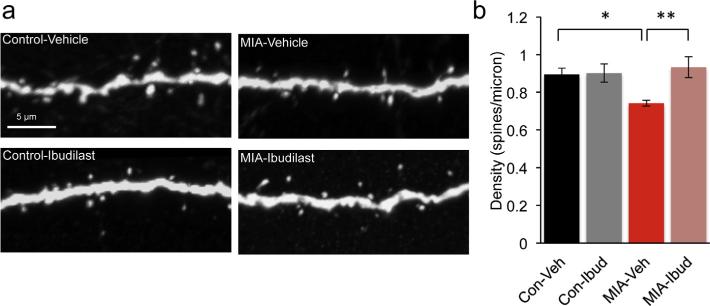Fig. 5.
Postnatal treatment with an anti-inflammatory drug ibudilast, prevents spine loss in young mice. (a) Layer 5 pyramidal neuron apical tuft dendrites from P17 control + vehicle, control + ibudilast, MIA + vehicle and MIA + ibudilast offspring mice treated during the first 2 postnatal weeks. (b) Two-way ANOVA was first used to test for the presence of interaction between drug treatment and experimental groups. This revealed an interaction consistent with the observation that ibudilast increased dendritic spine density in the MIA offspring but had no effect on the controls F(1, 20) = 6.296, P = 0.021. Post hoc two-way ANOVA with Bonferroni's correction confirm a reduction in spine density in MIA + vehicle offspring (control + vehicle: 0.89 ± 0.03 spines/micron, n = 6 mice; MIA + vehicle: 0.74 ± 0.01 spines/micron, n = 8, mice, P = 0.026) and that reduction is prevented by postnatal treatment with the anti-inflammatory drug ibudilast (MIA + ibudilast: 0.93 ± 0.05 spines/micron, n = 5 mice, MIA + vehicle: 0.74 ± 0.01 spines/micron, n = 8 mice, P = 0.007). No change in spine density in control + ibudilast offspring (control + vehicle: 0.89 ± 0.03 spines/micron, n = 6 mice; control + ibudilast: 0.90 ± 0.05 spines/micron, n = 5 mice, P > 0.9).

